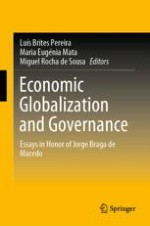2021 | OriginalPaper | Chapter
The Gold Standard and the Euro: Conjoined Twins or Distant Relations?
Author : Barry Eichengreen
Published in: Economic Globalization and Governance
Publisher: Springer International Publishing
Activate our intelligent search to find suitable subject content or patents.
Select sections of text to find matching patents with Artificial Intelligence. powered by
Select sections of text to find additional relevant content using AI-assisted search. powered by
